Tire size can be confusing. Some numbers on the sidewall are listed in millimeters while others are inches. Plus, the right size for your car, truck, or trailer can differ depending on where and how you drive.
You can see your original equipment tire size in your owner’s manual or on the placard generally located on the driver’s side door jam. This is the sizing recommended by the vehicle manufacturer.
If you’re interested in switching out your tires for a different look or performance, a good place to start is the numbers and other indicators on your existing tires’ sidewall. Next, have a tire professional help you determine a tire size range that will fit your vehicle and driving needs.
Here’s what those numbers and indicators on the sidewall indicate and how to understand them:
A: TIRE TYPE The first letter in the code tells you what class of tire it is.
P stands for passenger vehicle tire. P-class tires include cars, SUVs, crossovers, minivans and smaller pickup trucks.
LT means light truck tire, designed for vehicles that are capable of carrying heavy loads, towing trailers, or for those looking for an extra heavy duty option. These are often equipped on three-quarter or 1 ton trucks and SUVs.
ST stands for Special Trailer. These tire sizes are meant for trailers, including fifth wheels and other travel trailers, as well as boat and utility trailers.
If there’s no letter before the first number, you have a metric tire most commonly referred to as European size. It’s also measured in millimeters but may have a different load capacity than a P or LT tire.
B: TIRE WIDTH The three-digit number following the letter is the tire’s width (from side to side, looking at the tire head on) in millimeters. This may also be referred to as the section width.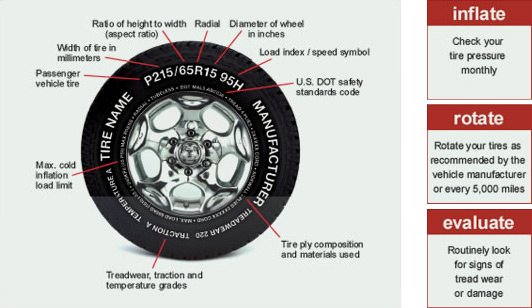
C: ASPECT RATIO The forward slash separates the tire width number from the two-digit aspect ratio. The bigger the aspect ratio, the higher/taller the tire’s sidewall, or “profile” as it’s sometimes called.
The aspect ratio is indicated on the tire sidewall as a percentage. It’s the height of the sidewall measured from wheel rim to top of the tread, expressed as a percentage of tire width.
In this example, the aspect ratio is 65, meaning the sidewall is 65 percent as high as the tire is wide. To get the sidewall height, take the tire width of 215 mm and convert it to inches (8.46). Then multiply this by 65% (.65). This gives you an answer of 5.5, the sidewall height in inches.
D: CONSTRUCTION TYPE This single letter tells you about the internal construction of the tire.
R is for radial tires, the industry standard for most tires today. They have better road grip, lower rolling resistance for better gas mileage, ride comfort and durability than previous generations of tires. In a radial tire, the plies — layers of strong cords made of a blend of polyester, steel and fabric and coated with rubber — are laid perpendicular to the direction of travel.
In a radial tire, the plies — layers of strong cords made of a blend of polyester, steel and fabric and coated with rubber — are laid perpendicular to the direction of travel.
D is for tires built with diagonal (crisscrossed) plies, called bias-constructed tires. They are also called conventional, x-ply, or cross-ply tires. Some motorcycle and trailer tires still use this internal construction.
Some run-flat tires are identified with an F followed by the type of internal construction.
E: WHEEL DIAMETER This two-digit number specifies wheel diameter in inches. It’s the distance between the two bead seat areas (where a tire gets tightly sealed onto the wheel).
F: LOAD INDEX The two-digit or three-digit number that follows the gap specifies tire load index. The load index symbol indicates how much weight a tire can support, based on the following standard chart. In our example, the load index is 89, which indicates the tire has a load capacity of 1,279 pounds, when inflated to the tire’s maximum air pressure rating.
G: SPEED RATING The last letter is the tire speed rating. This indicates the top speed it’s safe to travel at for a sustained amount of time. A tire with a higher speed rating can handle heat better and provide more control at faster speeds. The maximum operating speed of a vehicle is no more than the lowest speed rating of all tires mounted on the vehicle. (Of course, you should always abide by speed limits for safer driving.) Speed rating is usually, but not always, a single letter (see the chart).
Below you will find several charts that will help you understand tire sizing numbers, including a load index chart and speed rating chart.
A tire size calculator is a quick way to see whether the tire size you’re considering will likely fit your car, SUV, sports car, light truck or crossover.
But remember that is only an estimate. It’s important to stay within the sizing tolerances of your vehicle.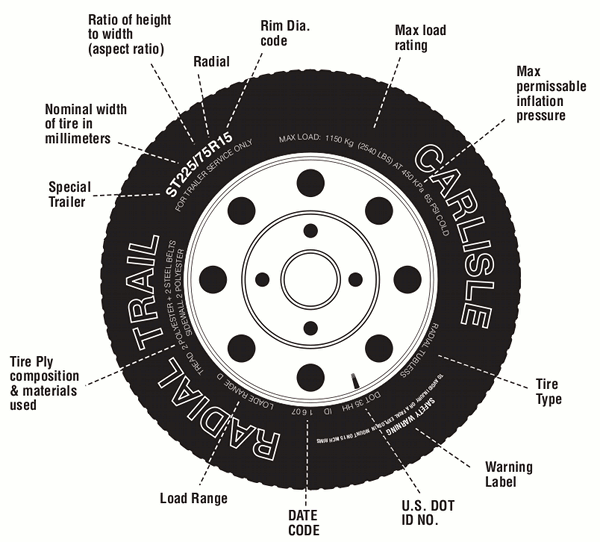 Tires that are the wrong size could cause some pull in the steering wheel, rub against the suspension or body of your vehicle, reduce clearance on hills, or result in a stiffer or noisier ride.
Tires that are the wrong size could cause some pull in the steering wheel, rub against the suspension or body of your vehicle, reduce clearance on hills, or result in a stiffer or noisier ride.
If you’re considering mounting a different tire size on your vehicle, check with a tire expert. Find out whether the tires and wheels you have your eye on are the right fit for your vehicle’s suspension, gearing, and bodywork. And ask how any differences in revolutions per mile, tire speed, load index, and speed rating will affect your ride quality and vehicle performance.
See how new tires and rims will look on your car or truck using our Virtual Wheels simulator, available at any Les Schwab.
Find Your Store
A tire sidewall showing its size in metric lists the width first, then the sidewall height (shown as a percentage of the tire width), followed by a letter to designate what type of carcass construction, and lastly the wheel/rim size.
Let’s look at the sidewall of this 245/245ZR17 G-Max AS-03:
245 is the section width (mm)
45 is the aspect ratio (%)
ZR with “R” representing radial construction & “Z” showing it’s rated for 149mph +
17 is the wheel diameter (inches)
95 is the load index
W is the speed rating
This G-Max tire is 245mm wide (about 9.6 inches wide), 25.6 inches tall, and fits a 17-inch wheel. It has a carrying capacity of 1,521 lbs and a maximum operating speed of 168 mph. Note that metric sizing uses both millimeters and inches, and requires conversions. Also, the speed rating references the testing and does not imply that the consumer drive at these high rates of speed.
U.S. Sizing
Certain light truck and heavy-duty tires use American (standard or imperial) measurement in inches. The tire height (or diameter) is most often listed first, followed by the section width, then the carcass construction type, and lastly the wheel size that the tire fits.
Let’s take this 33x12.50R17 Grabber AT2 for example:
33 is the tire height, or diameter (inches)
12.50 is the section width (inches)
R represents the carcass construction (radial)
17 is the wheel diameter (inches)
105 is the load index
Q is the speed rating
The tire is 33 inches tall, has a width of 12.50 inches, and fits onto a 17-inch wheel. It has a carrying capacity of 2,039 lbs and maximum operating speed of 99 mph.
Tire diameter
For American standard sizing, the tire height, or diameter, is listed directly in inches. On a metric tire, you’ll need to do some math. For metric sizing, take the section width and convert it to inches (divide by 25.4), then multiply that by the aspect ratio (shown as a percentage) to get the sidewall height. Next, take the sidewall height, double it, add the wheel diameter, and you’ll have the diameter of a metric tire.
Section width
This is shown in either millimeters or inches, but it refers to the overall carcass width, not the tread width.
Carcass construction
Most light truck and passenger vehicle tires built today are built with radial construction (“R”). This is shown before the wheel size. There are three basic types you can find produced today:
R Radial
B Bias belted
D Diagonal bias
Wheel size
Wheel size is shown in inches, regardless if it’s a metric or American sized tire.
Load Index
The load index shows the tire’s weight carrying capacity. While the load index is a numerical value, it is just a representative symbol for a certain carrying capacity and does not numerically correspond to carrying capacities (Example: Load index 85 indicates a carrying capacity of 1,135 pounds, not 85 pounds or 850 pounds or 8,500 pounds).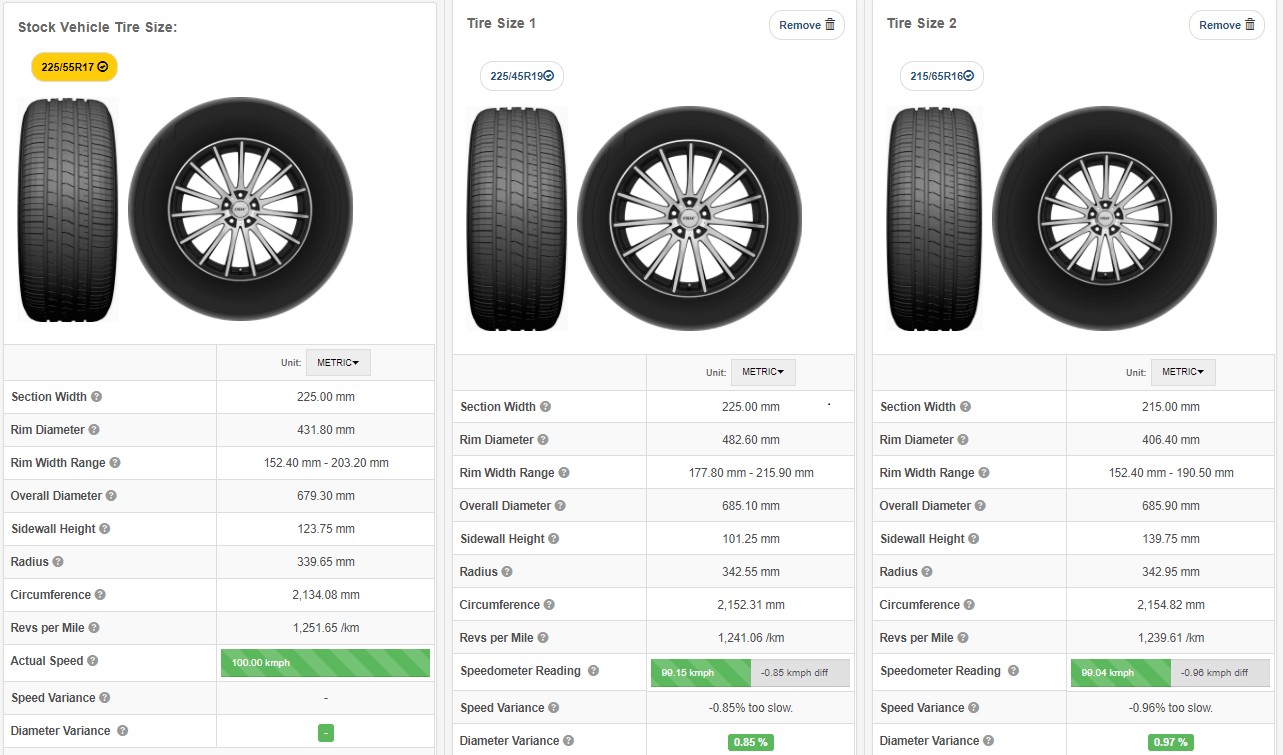
Speed Rating
Speed ratings are represented by letters ranging from A to Z. Each letter coincides to the maximum speed a tire can sustain under its recommended load capacity. For instance, S is equivalent to a maximum speed of 112 mph. Even though a tire can perform at this speed, we do not advocate exceeding legal speed limits.
Speed rating Maximum operating speed
| Rating Symbol | Speed | |||||
| P | 93 mph | |||||
| Q | 100 mph | |||||
| R | 106 mph | |||||
| S | 112 mph | |||||
| T | 118 mph | |||||
| H | 130 mph | |||||
| V | 149 mph | |||||
| W | 168 mph | |||||
| Y | 186 mph | |||||
| (Y) | Above 186 | |||||
For tires with a maximum speed rating abive 149 mph, a ZR may appear in the size designation. For tires above 186, a ZR must appear in the size desigination, and will inlcude a Y speed symbol in brackets For tires above 186, a ZR must appear in the size desigination, and will inlcude a Y speed symbol in brackets | ||||||
Service Type
Prior to (or sometimes following) the tire size—on both American and metric sizing—a tire may or may not have a letter showing the service type. Most consumers will deal with tires stamped with either “P” standing for passenger vehicle tire, or “LT” standing for Light Truck. But there are a number of others.
Here’s a quick reference guide:
P Passenger tire, often referred to as “P-metric”
LT Light Truck tire
T Temporary tire, or spare tire
ST Trailer tire (Special Trailer service)
C Commercial tire
1..png) What is the tire profile height and how to calculate it?
What is the tire profile height and how to calculate it?
2. What does the tire profile affect?
3. Increasing the tire profile: pros and cons
4. Reducing the tire profile: pros and cons
5. Do I need to change the profile height?
The tire profile is one of the key parameters that you need to pay attention to when choosing car tires. For each car, the manufacturer usually develops recommendations regarding what tire size should be and what deviations in these dimensions are acceptable. Deviations from the specified especially often concern the height of the tire profile. What affects the profile of the tire, and is it really necessary to change it? We understand.
What is tire profile height and how to calculate it?
Simply put, the height of a tire profile is practically its thickness, that is, the distance from the disk to the outermost surface of the tread.
The catch is that in the markings on the car tire itself, the profile height is not indicated directly in millimeters - it depends on the width of the tire.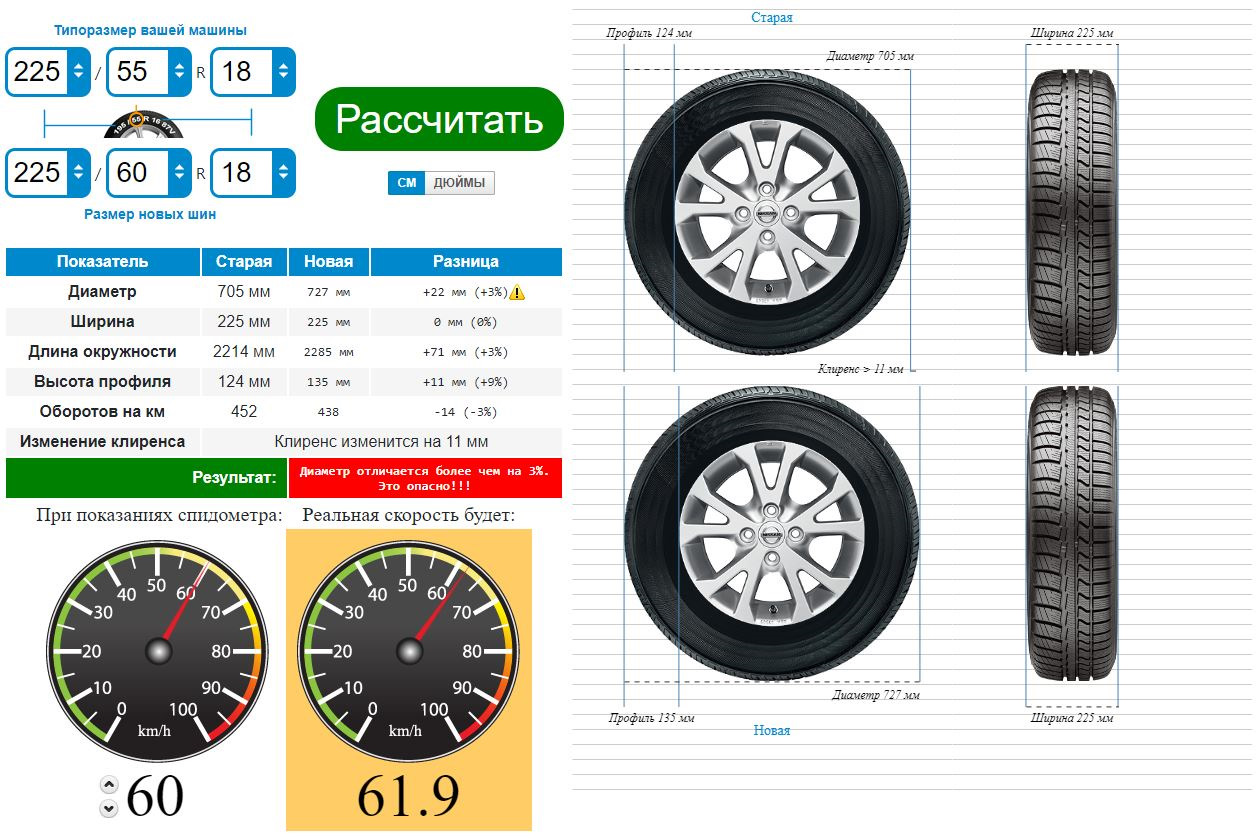
For example, the marking says that we have a tire of dimension:
215/50R17
The width is 215 mm, the profile height is 50% of this width, which means: 215 * 0.5 = 107.5 mm. What is important in this system of calculation? That with different tire widths with the same height percentage, the height will actually be different. So, for 225/50 tires, the profile height will already be 225 * 0.5 = 112.5 mm. So don't let the coincidence of the numbers after the fractional line on the marking mislead you - with different widths, the height will also be different.
Marking R17 in colloquial speech is often called the radius of the wheel, but this is not true. R stands for radial construction (how the cord fits in the tire), and the number is the fit or inner diameter of the tire in inches. So, we have 17-inch radial tires.
The labeling of American car tires is different from European ones. It is presented in the form
35×12. 50 R15
50 R15
There is no profile height data here, and all dimensions are measured in inches. 35 inches is the outer diameter of the tire, 12.50 is the width of the tire, and R15 is the already familiar 15 inches of the landing diameter. To calculate the profile, we connect geometry to arithmetic: subtract the inner diameter from the outer diameter, we get the “thickness” of the tire on both sides of the disk, divide it by two and get the profile. (35-15)/2= 10 inches. You can convert to meters according to the scheme 1 inch = 2.54 cm. Thus, the tire profile is 25.4 cm or 254 mm.
What is the profile of a tire?
As practice shows, even a slight deviation from the tire parameters specified by the manufacturer can affect how the car behaves on the road. For example, tires with a low profile and larger rims are easier to handle in turns, and a high tire profile increases flotation. It turns out that even with small changes in the height of the profile, you can slightly adapt the car to your driving style and road conditions.
How far you can deviate from the optimal dimension is another question. It is possible to reduce and increase the profile of the tire without changing the diameters of the wheel; it is enough to choose a larger or smaller disk, respectively. If the entire diameter of the tire increases, then problems may arise: when driving, the tire will touch the wheel arch or fender liner, which threatens with damage. And the wheel itself will become noticeably heavier, which will put an additional load on the suspension. Such changes are well tolerated by SUVs, since they are designed for additional load, but owners of ordinary passenger cars should think again.
Increasing the tire profile: pros and cons
Pros:
- while maintaining the width of the tire, a slight increase in the profile will make driving softer, especially when passing obstacles;
- reduces the risk of tire sidewall puncture;
- tires with a larger diameter (by 1-2 sizes) give a higher fit, which increases the patency of the tire.
Minuses:
- too high a tire profile will have a bad effect on braking and cornering performance;
- with an increase in the diameter of the tire, there is a risk of touching the body parts with tires, especially when the steering wheel is fully turned;
- Tires with a high profile weigh more, which gives an additional load on the suspension and the tires themselves when driving.
Tire profile reduction: pros and cons
Reducing the tire profile is not so often resorted to. This is usually due to the desire to give the car a more stylish and aggressive look. Tires with a low profile and a wide rim are usually reserved for sports cars and high-end cars with a sporty slant. And not in vain.
Pros:
- low-profile tires improve the car's responsiveness to handling and braking performance;
- tires with a low profile are more resistant to deformation during maneuvers and cornering;
- better grip on flat roads.
Minuses:
- low-profile tires are demanding on the quality of the road, since driving comfort on such tires drops sharply on uneven bumpy surfaces;
- tires with a low profile are noisier;
- the risk of deformation during long-term parking due to high pressure and an increased contact patch of the tire with the surface.
Do I need to change the height of the profile? conclusions
1. Low-profile tires are adapted to high-speed driving on highways and flat highways; they are unlikely to show their best side on domestic roads.
2. Increasing the profile of the tire while maintaining the diameter of the disk increases the vehicle's cross-country ability; an increase in the profile with a corresponding reduction in the disc increases driving comfort on rough roads.
3. Manufacturers advise deviating from the recommended tire profile sizes by no more than 3% for passenger cars. For trucks and light trucks, the spread can be more flexible.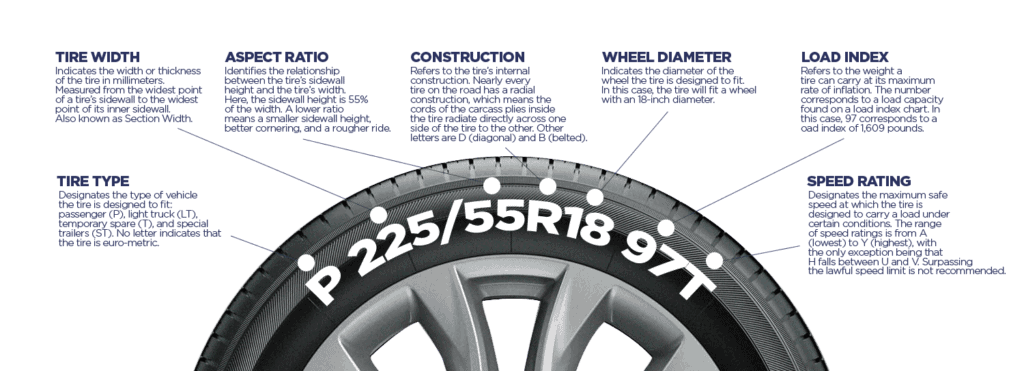
4. Changing the tire profile affects how your car behaves on the road. Responsiveness, softness of movement, acceleration and braking speed and many other characteristics will change, which will have to get used to again.
In simple terms, tire profile height is the distance from the rim to the wheel tread surface.
The height of the tire profile in metric size is marked on the wheel as a value that indicates a percentage of the tire width. For example, the dimension 215/65 R16 indicates that the height of the tire profile is 65% of the width of 215 mm and is 139.75 mm, with a wheel radius of 16 inches. The metric dimension is most common among the assortment of car tires in stores, so it will not be difficult to calculate the height of the tire profile. To convert metric to inch: 1 inch = 2.54 cm.
For example, the dimension 215/65 R16 indicates that the height of the tire profile is 65% of the width of 215 mm and is 139.75 mm, with a wheel radius of 16 inches. The metric dimension is most common among the assortment of car tires in stores, so it will not be difficult to calculate the height of the tire profile. To convert metric to inch: 1 inch = 2.54 cm.
Inch tire dimensions do not show the profile height in the marking, the overall wheel height, wheel width and tire radius are indicated in inches, for example, 31x10.5 R15. Tire conversion from inches to metric. To calculate the metric profile height, it is necessary to subtract its radius from the total wheel height, divide the resulting value of the total tire profile height in half and get the profile height. (31-15): 2=8" profile height, now 8x2.54cm=20.32cm metric profile height.
As a rule, car manufacturers recommend the optimal tire size for each particular car model and modification, with limits to possible deviations in size.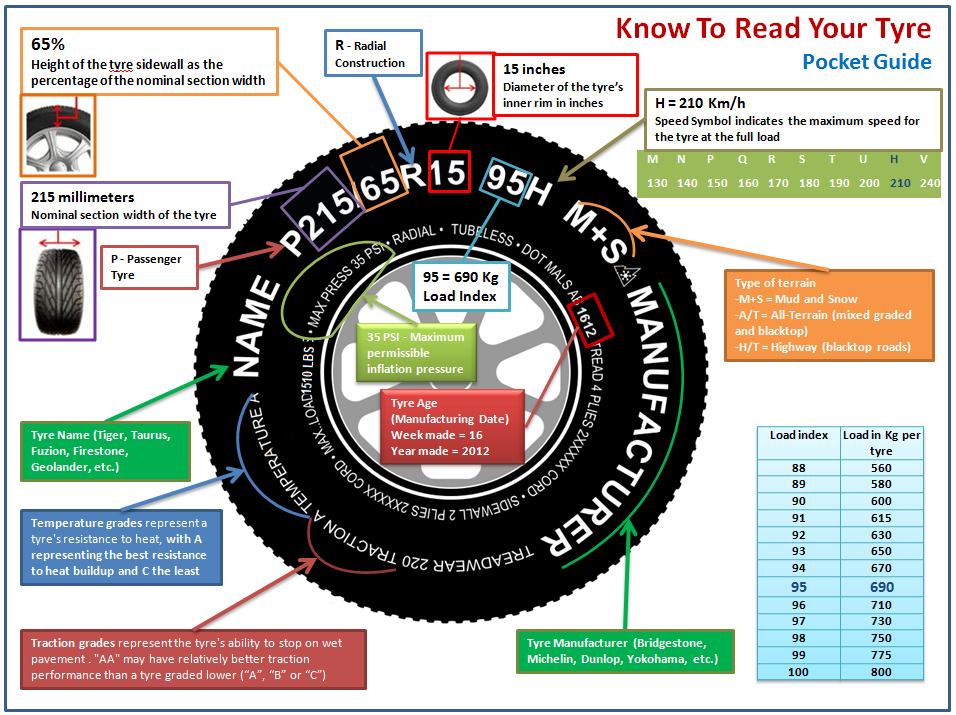 However, practice shows that even going beyond these dimensions can improve the driving performance of the car for each specific case, depending on the operating conditions and the requirements of the owner. When changing the standard size of a tire, it is necessary to understand what the height of the tire profile affects in order to be prepared for changes in the behavior of the car and possible consequences. By increasing or decreasing the profile of a tire, indicators such as stiffness, comfort, load and reliability change.
However, practice shows that even going beyond these dimensions can improve the driving performance of the car for each specific case, depending on the operating conditions and the requirements of the owner. When changing the standard size of a tire, it is necessary to understand what the height of the tire profile affects in order to be prepared for changes in the behavior of the car and possible consequences. By increasing or decreasing the profile of a tire, indicators such as stiffness, comfort, load and reliability change.
Increasing the tire profile within reasonable limits (1-2 sizes without increasing the width), the car will become softer and more comfortable, due to the larger diameter of the wheel, the car's landing will increase and its control will practically not worsen. If you exceed the allowable height of the profile, then the car will have a roll in control, deterioration in braking and cornering, due to an increase in the center of gravity and a crease of the rubber along the height of the profile, an increase in fuel consumption, possible grazing on the elements of the body and suspension at the moment of complete inversion of the steering wheel or at full load. And also, there will be an additional load on the chassis parts, which will reduce their service life.
And also, there will be an additional load on the chassis parts, which will reduce their service life.
Reducing the profile of a car tire without changing the width and radius will allow you to get better handling and improved braking. The lower the rubber profile, the less comfort, the car becomes stiffer, the load on the chassis parts increases, the chances of a wheel breakdown from hitting the disk and disk breakage increase due to the reduced tire donut, fuel consumption increases due to a decrease in tire diameter (fixed by increasing the wheel radius ). Moving along the path of reducing the profile and increasing the radius to equalize the overall diameter of the wheel, fuel consumption will remain without an increase, however, the rest of the nuances of low-profile rubber operation will remain.
Car owners are recommended:
.jpg)